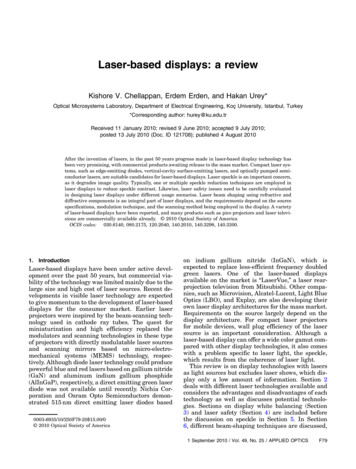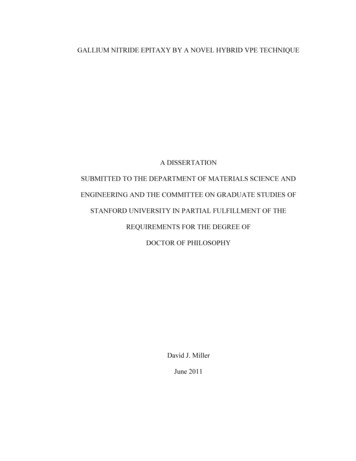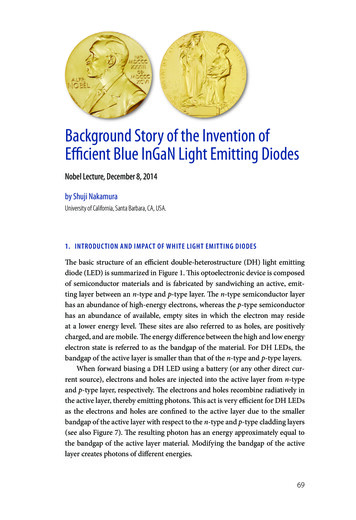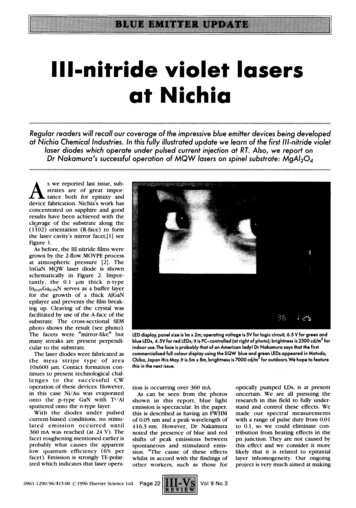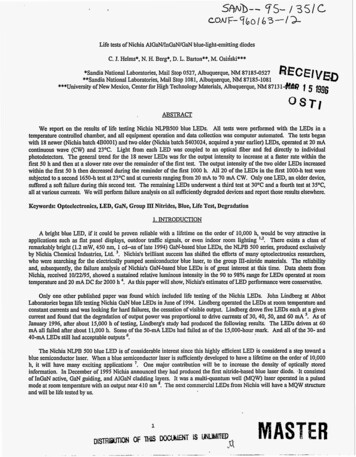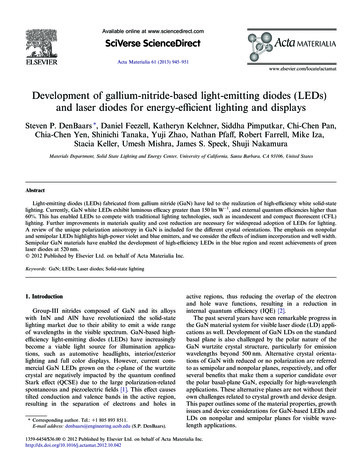
Transcription
Available online at www.sciencedirect.comActa Materialia 61 (2013) t of gallium-nitride-based light-emitting diodes (LEDs)and laser diodes for energy-efficient lighting and displaysSteven P. DenBaars , Daniel Feezell, Katheryn Kelchner, Siddha Pimputkar, Chi-Chen Pan,Chia-Chen Yen, Shinichi Tanaka, Yuji Zhao, Nathan Pfaff, Robert Farrell, Mike Iza,Stacia Keller, Umesh Mishra, James S. Speck, Shuji NakamuraMaterials Department, Solid State Lighting and Energy Center, University of California, Santa Barbara, CA 93106, United StatesAbstractLight-emitting diodes (LEDs) fabricated from gallium nitride (GaN) have led to the realization of high-efficiency white solid-statelighting. Currently, GaN white LEDs exhibit luminous efficacy greater than 150 lm W 1, and external quantum efficiencies higher than60%. This has enabled LEDs to compete with traditional lighting technologies, such as incandescent and compact fluorescent (CFL)lighting. Further improvements in materials quality and cost reduction are necessary for widespread adoption of LEDs for lighting.A review of the unique polarization anisotropy in GaN is included for the different crystal orientations. The emphasis on nonpolarand semipolar LEDs highlights high-power violet and blue emitters, and we consider the effects of indium incorporation and well width.Semipolar GaN materials have enabled the development of high-efficiency LEDs in the blue region and recent achievements of greenlaser diodes at 520 nm.Ó 2012 Published by Elsevier Ltd. on behalf of Acta Materialia Inc.Keywords: GaN; LEDs; Laser diodes; Solid-state lighting1. IntroductionGroup-III nitrides composed of GaN and its alloyswith InN and AlN have revolutionized the solid-statelighting market due to their ability to emit a wide rangeof wavelengths in the visible spectrum. GaN-based highefficiency light-emitting diodes (LEDs) have increasinglybecome a viable light source for illumination applications, such as automotive headlights, interior/exteriorlighting and full color displays. However, current commercial GaN LEDs grown on the c-plane of the wurtzitecrystal are negatively impacted by the quantum confinedStark effect (QCSE) due to the large polarization-relatedspontaneous and piezoelectric fields [1]. This effect causestilted conduction and valence bands in the active region,resulting in the separation of electrons and holes in Corresponding author. Tel.: 1 805 893 8511.E-mail address: denbaars@engineering.ucsb.edu (S.P. DenBaars).active regions, thus reducing the overlap of the electronand hole wave functions, resulting in a reduction ininternal quantum efficiency (IQE) [2].The past several years have seen remarkable progress inthe GaN material system for visible laser diode (LD) applications as well. Development of GaN LDs on the standardbasal plane is also challenged by the polar nature of theGaN wurtzite crystal structure, particularly for emissionwavelengths beyond 500 nm. Alternative crystal orientations of GaN with reduced or no polarization are referredto as semipolar and nonpolar planes, respectively, and offerseveral benefits that make them a superior candidate overthe polar basal-plane GaN, especially for high-wavelengthapplications. These alternative planes are not without theirown challenges related to crystal growth and device design.This paper outlines some of the material properties, growthissues and device considerations for GaN-based LEDs andLDs on nonpolar and semipolar planes for visible wavelength applications.1359-6454/ 36.00 Ó 2012 Published by Elsevier Ltd. on behalf of Acta Materialia 2
946S.P. DenBaars et al. / Acta Materialia 61 (2013) 945–9512. White GaN LEDsGaN is a direct band gap semiconductor material with a3.45 eV band gap which corresponds to near ultraviolet(UV) light (364 nm). GaN was first investigated as a potential material for LEDs in the late 1960s by Paul Maruskaand Jacques Pankove at the Radio Corporation of America(RCA) and in later years additionally by Isamu Akasaki [3]and co-workers at the Nagoya University in Japan andShuji Nakamura at the Nichia Corporation [4]. Earlyattempts to realize blue-emitting semiconductors initiallyfocused on SiC, but these devices proved to be inefficient(0.03% efficiency [5]) due to the material’s indirect bandgap. The GaN revolution has since provided efficient UV,violet and blue light emitters.Due largely to these achievements it is now possible toactually generate white light using GaN LEDs. The threemost popular and well-established approaches to usingLEDs to generate white light are shown in Fig. 1. Theyare a blue LED with yellow phosphors; a UV LED withblue and yellow phosphors (or red, green and blue phosphors); and a device that combines red, green and blueLEDs. Currently, the blue GaN LED plus yellow phosphordominates the white LED industry. The advantage to usinga blue LED and yellow phosphor is ease of manufactureand its high theoretical efficacy, which is attractive forthe creation of a cheap, bright white light source. However,this benefit comes at the expense of a lower color renderingindex value, which is typically low, and makes such devicesundesirable for indoor use. Typically an additional red orgreen phosphor is then added to the phosphor mix to getbroader spectral emission and hence higher CRI values.Violet and UV LEDs with tri-color phosphor mixtures provide better color rendering index (CRI) values and are suitable for indoor applications but at the expense of poorerefficacy. If one desires to dynamically control white light,the third approach, a combination of three (or more) LEDsof different wavelengths, is attractive, and will enablehigher efficacies than the UV phosphor LEDs, but will generally be the most expensive option of the three until further advances are made.The first two white LED approaches use phosphors forcreating broad-band white light by using a material whichabsorbs light of one wavelength and emits at longer wavelength. Phosphors are commonly used for this task and aselected few have received considerable attention, such asrare-earth doped yttrium aluminum garnets (YAG:RE,Y3Al5O12(RE)). For example, cerium-doped YAG canabsorb blue and UV light and emit yellow light relativelyefficiently [6]. Crucial to this process is the fact that higherenergy light (e.g. UV or blue) is converted to lower energy(e.g. yellow or red). Therefore, LEDs emitting red light –the lowest energy color in the visible spectrum – are notfeasible for white light generation using phosphors;instead, a short-wavelength UV, violet or blue LED isrequired. In addition, yellow LEDs made from InGaNare still not as efficient as blue InGaN LEDs pumpingyellow phosphors [7].3. LED efficiencyThere are several key performance parameters to consider when discussing LEDs. Recent research has focusedheavily on improving the external quantum efficiency(EQE) of an LED. The external efficiency is the ratio ofphotons externally emitted from the device, divided bythe electrons injected into the device. Over the past decademost of the improvements in materials and device designhave enabled the evolution of EQE from 25% in the early2000s [8], to over 70% for vertical LEDs (VLEDs) today,as shown in Fig. 2. The device improvements primarilyrelied on increased light extraction by either patterned sapphire substrates (PSSs) or roughening in VLEDs to achieveefficiencies of over 50%. Other LED parameters of importance included improving the internal quantum efficiency(IQE), that is, the ratio of photons generated to the numberWhite LightWhite LightWhite LightFig. 1. Three ways of generating white light from GaN LEDs: (a) combination of red, green and blue LEDs, (b) UV GaN LED plus three phosphors, and(c) blue GaN LED plus yellow phosphor. (For interpretation of the references to color in this figure legend, the reader is referred to the web version of thisarticle.)
S.P. DenBaars et al. / Acta Materialia 61 (2013) 945–9518070VLED60Bulk GaN50EQE (%) 40PSS30Std20Flip Chip1001998200020022004200620082010YearFig. 2. Evolution of external quantum efficiency over the past decade hasbeen driven by improvements in chip design and material improvements.of electron–hole recombinations through improvements inthe material quality, and reducing the defect density byusing bulk GaN substrates. In the case of white light generation, using phosphors with a high conversion efficiencyfactor enabled a high ratio of emitted longer wavelengthphotons to shorter wavelength absorbed photons, thusimproving the luminous efficiency. Future progress willheavily depend on improvements in all of the followingmajor areas: (1) internal quantum efficiency, (2) lightextraction efficiencies, (3) eliminating significant roll-off inEQE when operating LEDs at high currents to pushtoday’s peak laboratory EQE values of 70% to evenhigher values and (4) phosphor conversion efficiency.The IQE of today’s best LEDs has reached values higherthan 80% for blue 450 nm LEDs at low current densities( 30 A cm 2). Further improvements towards 100% IQEwill require a reduction of nonradiative pathways such asnonradiation recombination at defects and reduction innonradiative Auger recombination. Generally speaking,polar devices, which are currently the dominant devicesproduced in industry, experience “efficiency droop“ athigher drive currents. This efficiency droop is thought tobe caused in large part by the strong piezoelectric field inthe quantum wells (QWs), which in turn requires devicedesigns with very thin quantum well active layers(2.5 nm). Growing the LEDs from polar to nonpolar/semi-947polar crystallographic directions instead is needed, to eliminate strain-induced electric polarization fields currentlyseen within the QWs [9]. This topic is currently a majorresearch area as semiconductor growth techniques in nonpolar crystallographic directions are still immature [10].Growing in nonpolar/semipolar directions allows one tofurther optimize the devices structure, for example byincreasing the thickness of the QWs to greater than 8 nm[11], thereby further increasing the IQE at high currentdensity.As for the light extraction efficiency, due to large differences in the indices of refraction of air and the GaN materials system, a considerable fraction of the generatedphotons within the LED are trapped by total internalreflection. Methods under investigation include ways toincrease the amount of light hitting the LED/air interfaceat near perpendicular values to reduce the occurrence oftotal internal reflections (e.g. surface roughening techniques to generate micro-cones on the surface [12], optimizing the exterior shape of the LED chip and patterning thesapphire substrate to reduce light scattering), and methodsto eliminate the passage of light through certain layers ofmaterial by integrating/embedding photonic crystals intothe LED [13].One of the biggest problems when scaling LEDs to illumination level output powers is the roll-off in EQE seenwhen operating at higher current densities ( 10 A cm 2)when trying to increase the luminous flux (currently 160lumens per power LED chip (see Fig. 3), roughly equivalent to a 30 W incandescent bulb). This efficiency droopmay be associated with enhanced Auger recombination[14], or possibly carrier overflow from the quantum wellsdue to the high carrier population [15]. While the exactcause has not been determined yet, it is believed that theuse of thicker quantum wells and altering the device structure to lessen carrier overflow will reduce this effect to apoint that operating at higher efficacies and currents willbe possible. Nonpolar and semipolar materials are one ofthe most promising means to increase the width of thequantum wells in the active layer, and will be discussedin detail in the next section.Also, further progress in optimizing the phosphor materials and mixtures to improve the conversion efficiencies [6]and improve the quality of the white light through longerwavelength phosphor emission is being made and mustcontinue [16].4. Nonpolar and semipolar materialsFig. 3. White LEDs exhibit high luminous efficacies of 150 lm W 1 at lowdrive currents.Hexagonal wurtzite (WZ) GaN is the most thermodynamically stable crystal structure of GaN and the basalc-plane (0 0 0 1) is the most commonly used crystal orientation, as shown in Fig. 4. Wurtzite GaN is noncentrosymmetric, which lacks inversion symmetry, yieldinglarge built-in spontaneous polarization Psp in the[0 0 0 1] c-direction. The values for spontaneous polarization for (Al,In,Ga)N materials are nearly one-third the
948(a)S.P. DenBaars et al. / Acta Materialia 61 (2013) 945–951(b)Fig. 4. Crystal planes of GaN: (a) basal polar c-plane and (b) nonpolar mplane.values for typical perovskite ferroelectrics such asBaTiO3 [17].Stemming from the lattice mismatch of InN and GaN,InGaN QWs grown pseudomorphically on GaN substrateswill become elastically strained as long as it is below thecritical thickness for plastic relaxation. For c-plane GaN,this is a biaxially compressive stress that induces an additional piezoelectric polarization on the order of 1 MV cm 1[1]. For QW structures, the discontinuities in polarizationcause a build-up of sheet charges at the interfaces, producing an electric field that bends the energy bands, as illustrated in Fig. 5. This band bending directs the electronand hole wave functions in opposite directions, and theresulting spatial separation of confined carriers can reduceoscillator strength and recombination rates [18]. Additionally, the band bending reduces the transition energy of thebound states which can red-shift the emission wavelength.This effect, the quantum-confined stark effect (QCSE),C-Planecan have deleterious effects on optoelectronic devices andworsens for QWs with higher indium compositions dueto increased lattice mismatch, making it particularly detrimental for higher wavelength applications.An additional side-effect of the internal fields of c-planeGaN light emitters is that the emission peaks will graduallyblue-shift with increasing current densities, due to gradualCoulomb screening of the polarization-related internalelectric fields. For high current densities required for LDs(above 1 kA cm 2 and sometimes as high as 10 kA cm 2)this blue-shift of wavelength can be quite significant,requiring even higher indium compositions to realize thetarget wavelength. Minimizing the blue-shift with currentdensity can be possible by increasing the number of wells,which should reduce the effective carrier density in eachwell Additionally, stronger polarization fields in the activeregion may act as potential barriers for carrier transport,which can result in a high operating voltage. To avoid theseproblems, QWs grown on polar c-plane GaN are generallylimited to less than 3 nm in width.There are several symmetric nonpolar crystal planes thatoccur several times in the WZ unit cell, orthogonal to thebasal plane. Because of their crystal symmetry, the nonpolar a-planes 1 1 2 0 and m-planes 1 0 1 0 have zero inherentspontaneous polarization. Further, InGaN QWs grownon nonpolar GaN orientations do not induce any polarization discontinuities or suffer from any strain-induced piezoelectric polarization effects along to the growth direction.For QWs grown on nonpolar crystal orientations, theenergy bands remain flat, as shown in Fig. 5. Because thereis no spatial separation of electron and hole wave functions, the wave function overlap is essentially unity.There are a number of additional planes with a nonzeroh, or k, or i and nonzero l Miller–Bravais indices that canalso serve as growth surfaces. Since these mixed indexM-PlaneFig. 5. Band diagram for c-plane (polar) and m-plane (nonpolar) InGaN/GaN quantum wells. The piezoelectric field in c-plane leads to electron and holeseparation, whereas the nonpolar wells have minimal fields and good electron–hole pair overlap.
S.P. DenBaars et al. / Acta Materialia 61 (2013) 945–951Fig. 6. EQE vs. current density: at higher current densities c-plane LEDson bulk GaN exhibit efficiency droop (series 1), semipolar LEDs on bulkGaN exhibit less droop (series 2).949Fig. 7. Evolution of GaN laser diode wavelengths from violet, blue andrecent green wavelengths. (For interpretation of the references to color inthis figure legend, the reader is referred to the web version of this article.)4.1. Green GaN laser diodes1For interpretation of color in Figs. 3, 5 and 6 the reader is referred tothe web version of this article.While GaN is closing in on the green gap and could seeimmediate implementation in a variety of display applications, there have still been several challenges towardsachieving GaN LDs much beyond 450 nm. These longerwavelengths require high indium concentration in InGaNquantum well active regions, which can be difficult fromboth a growth and materials perspective, particularly onthe most commonly used basal c-plane GaN, which is limited by built-in polarization. The longest wavelength GaNLDs grown on the basal plane still have lower output powers and wall plug efficiencies (WPEs, a ratio of opticalpower output over the input current and voltage) compared to LDs in the pure blue spectrum: approximatelyone-tenth of the output power (80 mW compared to 800mW) and one-fourth of the WPE (5–6% compared to 20%).Orientations of GaN other than the standard basalplane have some very desirable properties that may makethem a better choice for solving the green-gap problem,the most important of which is the reduction or eliminationof the built-in polarization field that plagues polar c-planeInGaN devices as well as increased material gain. The firstviolet LDs on nonbasal orientations of GaN were demonstrated simultaneously by Mathews et al. at UCSB [19] andOkamoto et al. [20] in 2007 on m-plane ð1 0 1 0Þ GaN plane,11 years after the first c-plane LD demonstration. The firstsemipolar LD was demonstrated by Tyagi et al. [21] on5040EQE (%)planes have a c-axis component in their normal directionthey have some spontaneous polarization, and are collectively referred to as semipolar planes. The strength of thetotal polarization and the polarization discontinuitybetween strained InGaN layers and GaN substrate dependon both the angle from the c-plane and the composition ofthe InGaN layer.Over the past several years, semipolar LEDs and LDshave been explored on a variety of planes, includingð1 1 2 2Þ, ð1 0 1 1Þ and ð2 0 2 1Þ (oriented 58 , 62 and 75 from the c-plane, respectively. The ð2 0 2 1Þ semipolar orientation has so far shown the best performance forlonger wavelength applications, owing to reduced polarization effects compared to the c-plane, as well as otheradvantageous material qualities such as high compositional homogeneity in the QW and possibly increasedindium uptake.Recently we demonstrated semipolar ð2 0 2 1Þ blue1LED with high light output power (LOP) and low efficiency droop by utilizing a single 12 nm thick InGaNQW. Both LED structures were grown on bulk GaNwith similar defect densities, with the QW thicknessand reduced piezoelectric effect in the semipolar planebeing the main factor leading to the reduced droop.Fig. 6 shows the EQE of the semipolar ð2 0 2 1Þ blueLED vs. current density in comparison to c-plane LEDswith six 3 nm QWs. As seen in Fig. 6, semipolar blueLEDs show high EQEs of 50.1%, 45.3%, 43.0% and41.2% at 100, 200, 300 and 400 A cm 2, respectively,under pulsed conditions. The electroluminescence spectrum of the semipolar ð2 0 2 1Þ blue LEDs also showsvery little blue shift with increasing injection currentand a narrow full-width at half maximum (FWHM).These results indicate that semipolar LEDs are an attractive crystal orientation for reducing efficiency droop inblue LEDs.302010020002002200420062008YearFig. 8. Evolution of nonpolar LED external quantum efficiency as afunction of year. The development of bulk GaN crystals with low defectdensities in 2007 was a key breakthrough.
950S.P. DenBaars et al. / Acta Materialia 61 (2013) 945–951(a) Nonpolar QW on sapphire(b) Nonpolar QW on bulk GaNFig. 9. TEM of LEDs grown on nonpolar surface with (a) sapphire substrates and (b) bulk GaN substrates.free-standing ð1 0 1 1Þ later that year. Despite the relativelylate start in the race towards achieving lasing in the greenwavelengths, LDs on nonpolar and semipolar planes haveseen rapid improvements rivaling the best results on thec-plane, particularly at wavelengths in the blue and green,as shown in the summary of evolution of wavelength withtime in Fig. 7. Raring et al. recently demonstrated stateof-the-art blue and green LDs using unspecified nonbasalplanes of GaN, citing some of the highest WPEs reportedfor single-mode blue LDs at 23% [22]. Sumitomo Electricdemonstrated the first purely green (above 520 nm) LDson a semipolar ð2 0 2 1Þ plane in 2010, and at the time ofwriting, currently holds the record for longest wavelengthGaN-based LD ever reported, at 533.6 nm [23].4.2. Role of defects and compositional fluctuationsThe role of defects in GaN light emission efficiency isa complex and challenging issue. Early in the developmentof GaN LEDs researchers were surprised by the large number of defects (109 cm 2) that were present in surprisinglybright GaN LEDs [24]. LEDs made from other III-V materials systems would not show any light emission under suchlarge defect densities. The reason c-plane InGaN LEDs arethought to be bright in spite of large defects is because oflocalized states in the InGaN alloys which exist in theactive region of InGaN quantum wells [25,26]. The mechanism of InGaN localization is still under research, withphase separation [27] and stress [28] being two of the leading theories on the driving force for localized InGaN states.In the nonpolar orientations the role of defect reduction inbulk GaN is more clear and led to a fivefold increase in theexternal quantum efficiency [29]. The development of truebulk GaN substrates in 2007 was a key enabler in achievingbright InGaN LEDs on nonpolar surfaces. As shown inFig. 8, LED quantum wells grown on bulk GaN with a defect density of 106 cm 2 showed an EQE as high as 45%.Transmission electron micrographs (TEMs) of nonpolarLEDs grown on bulk GaN show significantly lower defectdensities than those grown on sapphire (see Fig. 9).5. ConclusionIn conclusion, white light sources based on III-nitrideLEDs have a promising future, and continued advancements in materials science and device engineering areexpected to enable luminous efficacies over 200 lm W 1.Nonpolar and semipolar GaN-based LEDs and laserdiodes show great promise in achieving lower efficiencydroop and longer wavelengths. As the manufacturing costsdecrease, becoming similar to other semiconductor products, cost-effective drop-in replacements for incandescentbulbs will be readily available in the next couple of years.AcknowledgementsThe authors would like to thank Mitsubishi ChemicalCorporation for the supply of bulk GaN substrates. Theauthors acknowledge the Solid State Lighting and EnergyCenter (SSLEC) at UCSB and the support of the NSFMRSEC program (DMR 1121053) for MRL characterization facilities. A portion of this work was performed in theUCSB nanofabrication facility, part of the National Science Foundation (NSF)-funded National NanotechnologyInfrastructure Network (NNIN).References[1] Bernardini F, Fiorentini V, Vanderbilt D. Phys Rev B 1997;56:10024.[2] Fiorentini V, Bernardini F, Della Sala F, Di Carlo A, Lugli P. PhysRev B 1999;60:8849.[3] Akasaki I, Amano H, Itoh K, Koide N, Manabe K. GaN-basedultraviolet/blue light emitting devices. Inst Phys Conf Ser1992;129:851–6.[4] Nakamura Shuji, Senoh Masayuki, Iwasa Naruhito, Nagahama Shinichi. Physica B 1993;185:453.[5] Edmond JA, Kong H-S, Carter Jr CH. Physica B 1993;185:453.[6] Allen Steven C, Steckl Andrew J. Appl Phys Lett 2008;92:143309.[7] Sato H, Chung RB, Hirasawa H, Fellows N, Masui H, Wu F, et al.Appl Phys Lett 2008;92:221110.[8] Narukawa Yukio, Sano Masahiko, Sakamoto Takahiko, YamadaTakao, Mukai Takashi. Phys Status Solidi (a) 2008;205:1081.[9] Waltereit P, Brandt O, Trampert A, Grahn HT, Menniger J,Ramsteiner M, et al. Nature 2000;406:865.[10] Yamada H, Iso K, Saito M, Hirasawa H, Fellows N, Masui H, et al.Phys Status Solidi (RRL) 2008;2:89.[11] Kim Kwang-Choong, Schmidt Mathew C, Sato Hitoshi, Feng Wu,Fellows Natalie, Jia Zhongyuan, et al. Appl Phys Lett2007;91:181120.[12] Fujii T, David A, Gao Y, Iza M, DenBaars SP, Hu EL, et al. PhysStatus Solidi (c) 2005;2:2836.[13] Erchak AA, Ripin DJ, Fan S, Rakich P, Joannopoulos JD, Ippen EP,et al. Appl Phys Lett 2001;78:563.[14] Shen YC, Mueller GO, Watanabe S, Gardner NF, Munkholm A,Krames MR. Appl Phys Lett 2007;91:141101.[15] Vampola KJ, Iza M, Keller S, DenBaars SP, Nakamura S. Appl PhysLett 2009;94:166432.
S.P. DenBaars et al. / Acta Materialia 61 (2013) 945–951[16] Ronda CR. J Luminesc 1997;72–74:49.[17] Speck JS, Chichibu SF. Nonpolar and semipolar Group III nitridebased materials. MRS Bull 2009;34(05):304–12.[18] Seo Im J, Kollmer H, Off J, Sohmer A, Scholz F, Hangleiter A. PhysRev B 1998;57(16):R9435–8.[19] Schmidt Mathew C, Kim Kwang-Choong, Farrell Robert M, FeezellDaniel F, Cohen Daniel A, Saito Makoto, et al. Jpn J Appl Phys, Part2 2007;46(8–11):L190–L191[20] Okamoto K, Ohta H, Chichibu SF, Ichihara J, Takasu H. Jpn J ApplPhys 2007;46(9):L187–9.[21] Tyagi Anurag, Farrell Robert M, Kelchner Kathryn M, Huang ChiaYen, Hsu Po Shan, Haeger Daniel A, et al. Appl Phys Express2010;3(1):011002.[22] Raring JW, Schmidt MC, Poblenz C, Chang Y-C, Mondry MJ, Li B,et al. Appl Phys Express 2010;3(11):112101.951[23] Adachi Masahiro, Yoshizumi Yusuke, Enya Yohei, Kyono Takashi,Sumitomo Takamichi, Tokuyama Shinji, et al. Appl Phys Express2010;3(12):121001.[24] Lester SD, Ponce FA, Craford MG, Steigerwald DA. Appl Phys Lett1995;66(10):1249.[25] Chichibu S, Sota T, Wada K, Nakamura S. J Vac Sci Technol1998;16(4):2204.[26] Rao M, Kim D, Mahajan S. Appl Phys Lett 2004;85(11):1961.[27] Ho IH, Stringfellow GB. Appl Phys Lett 1996;69(18):2701.[28] Zhang QL, Meng FY, Crozier PA, Newman N, Mahajan S. ActaMaterialia 2011;59(10):3759.[29] Kim KC, Schmidt MC, Sato H, Wu F, Fellows N, Saito M, et al.Phys Status Solidi-Rapid Res Lett 2007;1(3):125.
the GaN material system for visible laser diode (LD) appli-cations as well. Development of GaN LDs on the standard basal plane is also challenged by the polar nature of the GaN wurtzite crystal structure, particularly for emission wavelengths beyond 500 nm. Alternative crystal orienta-tions of
